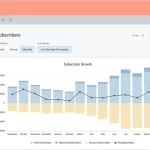
That predictable, recurring revenue stream feels like a dream, doesn’t it? A steady flow of income, month after month. It’s the holy grail for modern businesses. But here’s the deal: the accounting reality behind that dream can be a real headache.
Honestly, moving from a one-time sale model to a subscription model is like switching from a simple sprint to a complex, ongoing relay race. The rules of the game change completely. You’re no longer just recording a single transaction; you’re managing a living, breathing financial relationship with your customer.
It’s Not Your Money (Yet): The Beast of Revenue Recognition
This is, without a doubt, the biggest mental shift. When a customer pays you $120 for an annual subscription, you can’t just log that entire amount as revenue on day one. That cash is sitting in your bank account, but it’s not really all yours. Not yet.
Think of it as an advance payment for services you still owe. You have to earn that revenue over the life of the subscription. This is the core principle of ASC 606 and IFRS 15—the accounting standards that govern this space. So, that $120 becomes $10 of recognized revenue each month for twelve months.
It sounds straightforward, but the complexity can be staggering. What if you offer a free trial? A one-month discount? A setup fee? Suddenly, you’re not just dividing a simple number. You’re allocating the total contract value across different performance obligations, and let me tell you, it gets messy fast.
Deferred Revenue: The Liability That’s Actually a Good Thing
All that money you’ve collected but haven’t earned yet? It lives on your balance sheet as “Deferred Revenue” or “Unearned Revenue.” And it’s classified as a liability. Which feels counterintuitive, right? How can cash in the bank be a liability?
Well, because you have an obligation. You owe your customer a service. If you shut down tomorrow, you’d technically have to refund that unearned portion. So, it’s a debt to your future self. Watching this liability grow is actually a sign of a healthy, growing subscription business. It’s your future revenue, waiting in the wings.
The Churn Conundrum: Accounting for the Vanishing Customer
In the subscription world, customers come and go. Churn—the rate at which customers cancel—is a constant specter. And it directly impacts your accounting.
When a customer cancels, you have to stop recognizing revenue for their subscription. But more than that, you might need to account for any remaining deferred revenue associated with that customer. For annual plans paid upfront, a mid-year cancellation could mean reversing some of that deferred revenue you’d been carefully amortizing.
It creates a level of uncertainty that traditional businesses don’t face. Your recognized revenue isn’t just a function of sales; it’s a function of sales minus churn, and that’s a moving target.
Variable Considerations and The Complexity of Discounts
Let’s say you run a promotion: “First three months for $1, then $20/month.” How in the world do you account for that? This is what accountants call a “variable consideration.” You have to estimate the total transaction price, which includes forecasting the likelihood of the customer sticking around after the promotional period ends.
You can’t just recognize $1 for the first three months. You have to allocate the total expected value of the contract across the entire expected subscription period. It requires judgment, estimation, and a lot of spreadsheet gymnastics. One wrong assumption and your revenue numbers are off.
Operational Headaches: The Practical Nightmares
Beyond the high-level principles, the day-to-day grind presents its own set of challenges.
The Billing & Invoicing Tangle
Managing different billing cycles—monthly, quarterly, annual—is a logistical puzzle. Prorating charges for mid-cycle upgrades or downgrades? It’s enough to make your head spin. A simple billing error can cascade into a revenue recognition nightmare, leading to frustrated customers and messy financial corrections.
Tax Compliance Across Jurisdictions
If you sell digital subscriptions globally, you’re suddenly navigating a labyrinth of international tax laws. VAT, GST, sales tax—the rules for digital services are a patchwork quilt of regulations that change constantly. Determining the correct tax to charge and remit for a customer in Berlin versus one in Brisbane is a full-time job in itself.
Data Silos and System Sprawl
Often, your CRM (like Salesforce) holds the customer data, your payment processor (like Stripe) handles the cash, and your accounting software (like QuickBooks or Xero) tries to make sense of it all. When these systems don’t talk to each other seamlessly, you’re left manually reconciling data. This is a recipe for errors, delays, and a whole lot of wasted time.
Finding Your Way Through the Maze: Practical Steps
So, what can you do? Well, you can’t just ignore it. Here are a few paths forward.
Invest in the Right Tools: Generic accounting software often falls short. Look into subscription-specific platforms like Zuora, or ensure your existing ERP has robust subscription management modules. Automation is your best friend here.
Embrace GAAP from Day One: Even if you’re a startup, adopting Generally Accepted Accounting Principles (GAAP) for your subscriptions early on will save you immense pain during an audit or a funding round. Clean books build trust.
Get Professional Help: Don’t try to be a hero. A good accountant or CFO who understands the nuances of ASC 606 is worth their weight in gold. They can set up your processes correctly from the start.
In the end, the subscription model is a powerful engine for growth. But that engine needs a sophisticated financial dashboard to run smoothly. By confronting these accounting challenges head-on, you’re not just doing busywork. You’re building a foundation of financial clarity that allows you to truly understand your business’s health—beyond just the top-line subscriber number.
You’re moving from guessing to knowing. And in the volatile world of business, that knowledge is everything.







